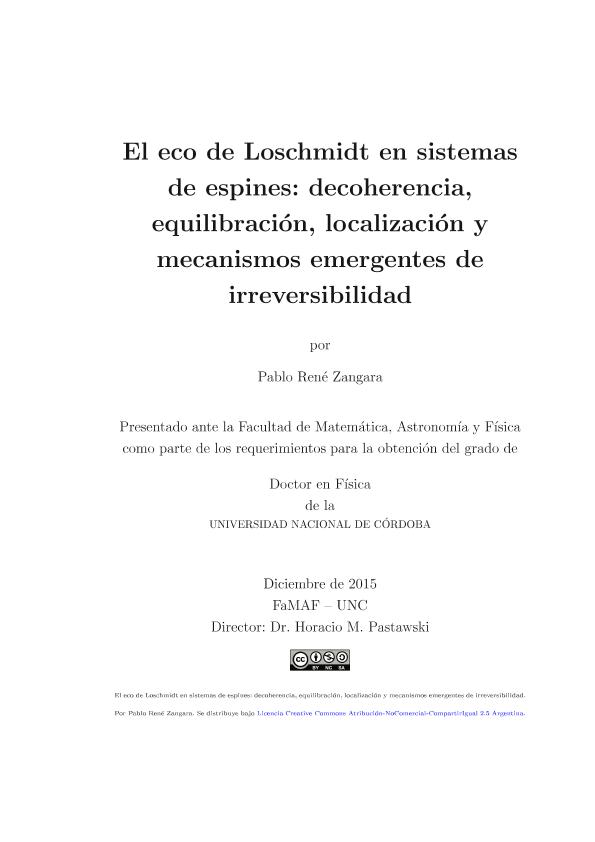Mostrar el registro sencillo del ítem
dc.contributor
Pastawski, Horacio Miguel

dc.contributor.author
Zangara, Pablo René

dc.date.available
2019-06-28T18:15:19Z
dc.date.issued
2015-12-04
dc.identifier.citation
Zangara, Pablo René; Pastawski, Horacio Miguel; El eco de Loschmidt en sistemas de espines: decoherencia, equilibración, localización y los mecanismos emergentes de irreversibilidad; 4-12-2015
dc.identifier.uri
http://hdl.handle.net/11336/78910
dc.description.abstract
Los fenómenos irreversibles son omnipresentes en la naturaleza. En el mundo microscópico, por ejemplo, un exceso de polarización magnética difunde en un sistema de espines interactuantes hasta desparramarse completamente. En esta Tesis estudiamos la dinámica de tal proceso para sistemas abiertos y cerrados. El primer caso corresponde al fenómeno de decoherencia inducida por un ambiente externo, mientras que el segundo engloba dos fenómenos opuestos que pueden ocurrir en sistemas cerrados: la equilibración de observables y la localización de muchos cuerpos. Utilizamos como testigo dinámico al eco de Loschmidt, una magnitud que se define a partir de una reversión temporal imperfecta y que puede evaluarse experimentalmente en resonancia magnética nuclear. Estudiando tal eco y sus escalas de tiempo características, identificamos los mecanismos emergentes que rigen la irreversibilidad en el límite termodinámico.
dc.description.abstract
If an ink drop falls into a pond, the stain diffuses away until no trace of it remains whatsoever. One may naturally say that such a process is in fact irreversible. In the microscopic world, similar phenomena are also ubiquitous. For instance, if a magnetic polarization excess is injected in manyspin system which is initially in thermal equilibrium, then this “excitation” would spread all over as consequence of spin-spin interactions. Such an apparently irreversible process is known as spin diffusion and it can lead the system back to “equilibrium”. One can generalize this idea by considering a closed many-body quantum system which is departed from equilibrium and, even when it evolves unitarily, many local observables have some transient behavior and then remain close to a static value for most of the time. This process is known as equilibration, which is one of the central issues to be addressed in this Thesis. The idea of equilibration in closed quantum systems soon faces limitations. On the one hand, the equilibration of the polarization is not always the rule as there are physical situations where the initial excitation cannot spread at all. Such a situation occurs when the system is sufficiently disordered or when the internal interactions are too strong. In fact, these extreme regimes give rise to the well known Anderson localization and Mott insulating phases respectively. For arbitrary strengths of disorder and interactions, the interplay between both processes is highly non-trivial. We obtain and discuss a dynamical phase diagram which shows the parametric regions where a many-body system equilibrates. On the other hand, even in the cases where the system seems to have equilibrated, the unitarity of quantum dynamics ensures a precise memory of the non-equilibrium initial condition. Then, if some experimental protocol could reverse the many-body dynamics, it would drive the system back to the initial non-equilibrium state. Such a general idea defines the Loschmidt echo (LE), which embodies the various time-reversal procedures implemented in nuclear magnetic resonance. As a matter of fact, the reversal is always perturbed by uncontrolled internal or environmental degrees of freedom as well as by imperfections in the pulse sequences. These perturbations constitute the sources of decoherence, a phenomenon closely tied to the LE degradation. Indeed, throughout this Thesis we address systematically how to calculate, both analytically and numerically, the perturbation-dependent decoherence time τΣ. In most of the cases considered, this is precisely understood in terms of the the Fermi golden rule (FGR). Last, but definitely not least, we address a general picture of the LE decay as a consequence of the interplay between the reversible interactions (characterized by a time scale T2) and the perturbation (τΣ). This would ultimately lead to the experimentally observed T3, which was found to be roughly independent of τΣ but closely tied to T2. Here, we evaluate the LE in a sequence of closed systems of increasing size and perform a finite size scaling on the time scales of the LE decay. Such an approach provides numerical evidence supporting an emergent mechanism based on the proliferation of effective interactions mediated by highly excited states. In turn, this justifies an effective FGR description of the LE dynamics. Thus, in the thermodynamic limit, any arbitrarily small perturbation yields a characteristic FGR time, and if the system stays equilibrated during a longer time, then the equilibration will become irreversible for any practical purpose.
dc.format
application/pdf
dc.language.iso
spa
dc.rights
info:eu-repo/semantics/openAccess
dc.rights.uri
https://creativecommons.org/licenses/by-nc-sa/2.5/ar/
dc.subject
Eco de Loschmidt
dc.subject
Equilibración
dc.subject
Localización de Muchos Cuerpos
dc.subject
Decoherencia
dc.subject
Irreversibilidad
dc.subject
Fenómenos Emergentes
dc.subject
Resonancia Magnética Nuclear
dc.subject
Termalización
dc.subject
Regla de Oro de Fermi
dc.subject.classification
Física Atómica, Molecular y Química

dc.subject.classification
Ciencias Físicas

dc.subject.classification
CIENCIAS NATURALES Y EXACTAS

dc.title
El eco de Loschmidt en sistemas de espines: decoherencia, equilibración, localización y los mecanismos emergentes de irreversibilidad
dc.type
info:eu-repo/semantics/doctoralThesis
dc.type
info:eu-repo/semantics/publishedVersion
dc.type
info:ar-repo/semantics/tesis doctoral
dc.date.updated
2019-06-24T13:39:03Z
dc.description.fil
Fil: Zangara, Pablo René. Consejo Nacional de Investigaciones Científicas y Técnicas. Centro Científico Tecnológico Conicet - Córdoba. Instituto de Física Enrique Gaviola. Universidad Nacional de Córdoba. Instituto de Física Enrique Gaviola; Argentina
dc.relation.alternativeid
info:eu-repo/semantics/altIdentifier/url/http://hdl.handle.net/11086/2765
dc.conicet.grado
Universitario de posgrado/doctorado

dc.conicet.titulo
Doctor en Física
dc.conicet.rol
Autor

dc.conicet.rol
Director

dc.conicet.otorgante
Universidad Nacional de Córdoba. Facultad de Matemática, Astronomía y Física

Archivos asociados
